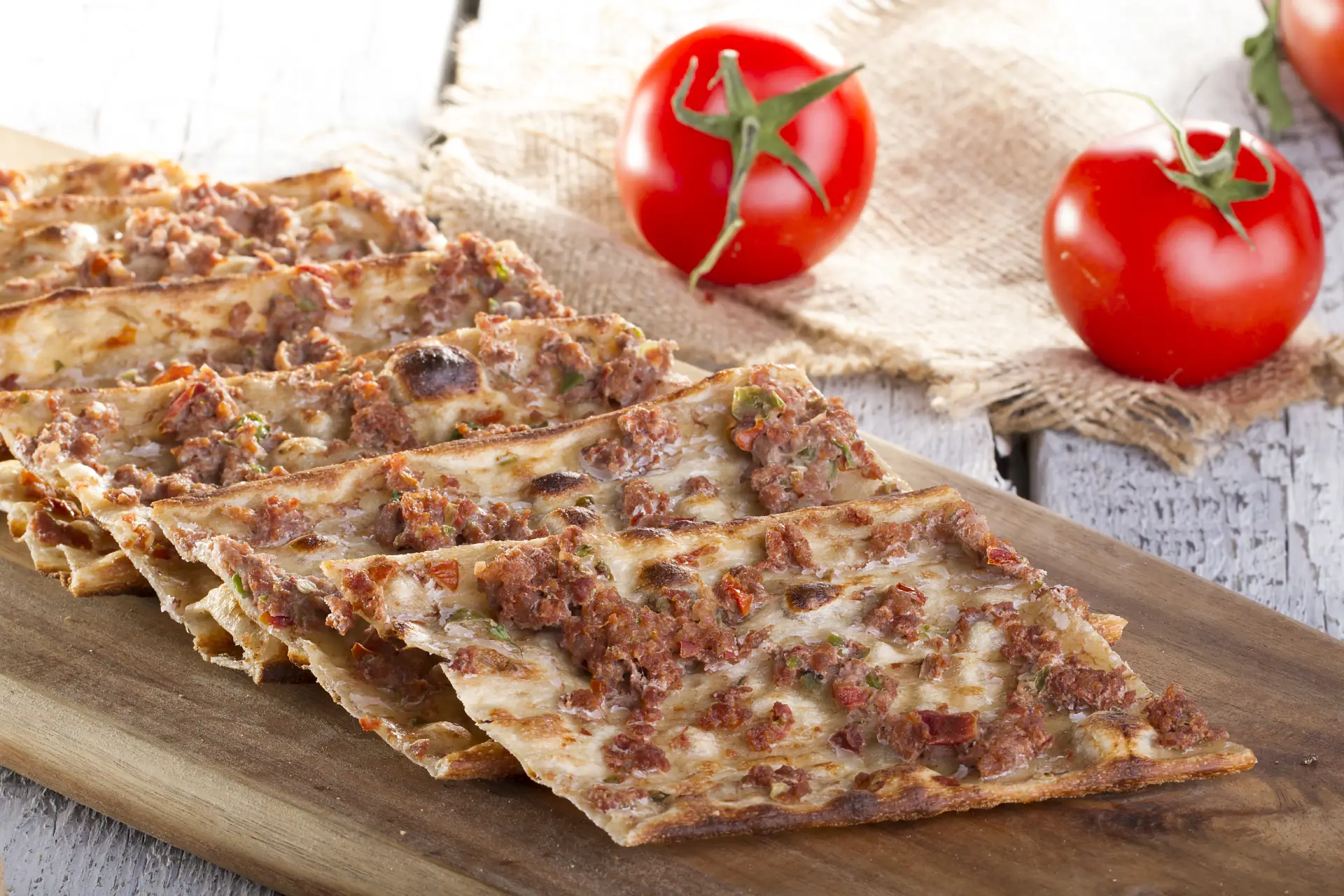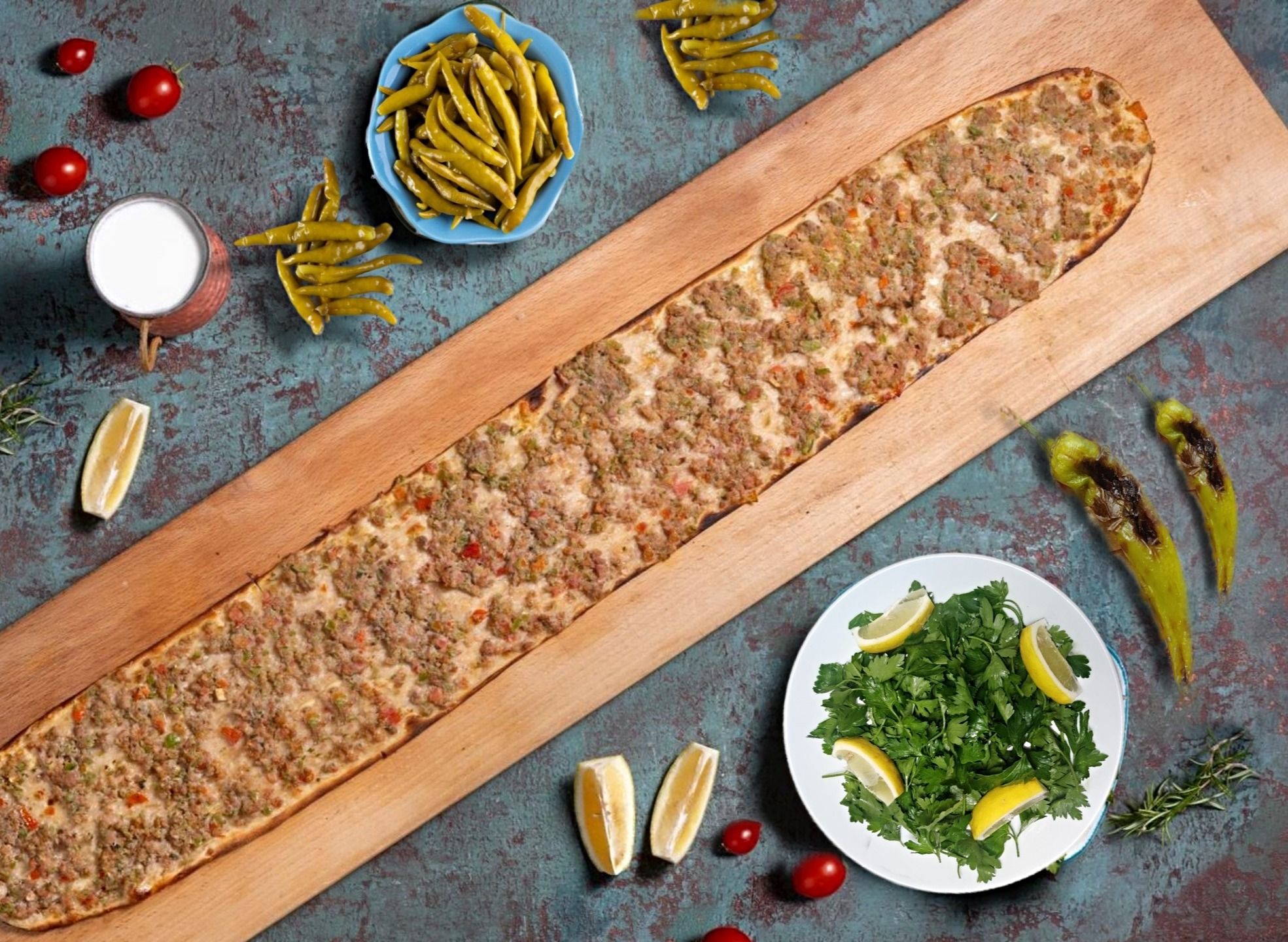You've arrived in Konya, the enchanting spiritual atmosphere of Rumi has embraced you, and now you have that one, delicious question on your mind: What to eat in Konya? If you're looking for the answer, don't worry, you're in the right place. Because eating in Konya is not just about filling your stomach; setting a table in this city is like reading a deep-rooted history book stretching from the Seljuks to the present day, it's about tasting a living culture. In this guide, we won't just leave you with a food list; we'll tell you the stories, tips, and best addresses for the holy trinity of Konya's cuisine: the legendary Etli Ekmek, the patiently cooked Fırın Kebabı, and the surprising Bamya Çorbası. If you're ready, let's embark on an unforgettable journey on the flavor map of Konya!
Try the thin and long Etli Ekmek, Konya's geographically indicated delicacy

You can't visit Konya and leave without trying etli ekmek. But first, let us remind you of a golden rule: Don't you dare call it pide! The people of Konya are very sensitive about this because, for them, etli ekmek is much more than a pide; it's a work of art. With its paper-thin dough, crispy texture, and a length approaching a meter, etli ekmek is a feast in itself. This delicacy is so special that on June 9, 2017, it was protected by receiving a Geographical Indication with registration number 214 from the Turkish Patent and Trademark Office.
So, what should a real Konya Etli Ekmek be like? According to the standards, its length should be around 85-90 cm, and its width 15-20 cm. Its dough is leavened, which is one of the main differences that sets it apart from lahmacun. The filling consists of minced meat from veal or heifer, tomatoes, green peppers, and onions. This mixture is spread onto the dough stretched by the masterful hands of a tırnakçı (dough master) and slid into the stone oven, fired with oak wood, by a kürekçi (oven master).
There are countless places in Konya where you can taste this delicacy. Cemo Etliekmek is one of the city's most well-known and popular spots. In this place, which gets quite crowded especially at lunchtime, you can try the classic etli ekmek as well as varieties like bıçakarası (made with hand-minced meat instead of ground) and Mevlana (with cheese). For a more modest but equally authentic experience, you can choose places favored by the locals like Halk Etliekmek or Ferah Etliekmek. While discovering the best food stops in Konya, you can take a break among Konya's historical bazaars and look for these flavors.
Eat Fırın Kebabı, prepared by slow-cooking lamb in an oven for hours

If etli ekmek is the star of Konya cuisine, then Fırın Kebabı is its soul. The origin of this historical delicacy dates back to the Seljuk Empire, and its name is even mentioned in the works of Rumi. This kebab leaves its mark on the palate not with a symphony of spices, but with the power of simplicity. Only the foreleg and rib meat of lambs from the Konya and Karaman region are used in its making.
The secret of Fırın Kebabı (or Furun Kebabı in the local dialect) lies in its cooking technique. The meats are placed in large copper cauldrons and cooked slowly for about 5 to 7 hours in stone ovens fired with oak wood, with no additives other than its own fat and a little rock salt. At the end of this patient wait, the meat reaches a consistency that is as soft as Turkish delight, melting in your mouth.
There is also a custom, a ritual, to eating this kebab. Don't ask for a fork and knife! As the masters recommend, Fırın Kebabı is eaten by hand. The pleasure of tearing off a piece of your warm tırnak pide, and scooping up those tender pieces of meat and its delicious fat is priceless. It is accompanied only by a dry onion and a frothy ayran. For this unique experience, you must visit Hacı Şükrü, which has been serving since 1907; it's practically a kebab temple. Another legendary address is Ali Baba Fırın Kebap, which has been offering the same taste since 1974.
Start your meal with Bamya Çorbası, the local wedding soup

One of the most surprising flavors on the Konya table will definitely be Bamya Çorbası (Okra Soup). This soup is very different from any soup you know. It's not just a starter; it's an indispensable cultural symbol of Konya's wedding, holiday, and special invitation tables. In fact, its role in the Konya wedding menu is so special that it is often served after the dessert. Yes, you heard that right!
In Konya's traditional feasts, this slightly sour soup, served after desserts like semolina halva, is intended to cleanse the palate and prepare the stomach for the upcoming meaty main courses. This is the most beautiful proof of how refined and planned Konya's gastronomic culture is. The main ingredient of the soup is tiny, sun-dried flower okras strung on threads. These okras are boiled in lemon water to remove their slimy texture and then cooked with tiny, diced lamb meat.
The resulting flavor is a perfect combination of the richness of the meat and the refreshing sourness of the lemon. If you want to try this special soup in an authentic atmosphere, Lokmahane, which offers flavors from Seljuk and Ottoman cuisine, is a great option. For a more modest experience that reflects the spirit of local artisans, you can choose the historic soup shop Efe Çorba, which has been in service since 1930. After tasting this unique soup, you will have made a great start to your visit to the spiritual heart of Konya, the Mevlana Museum.
Continue Exploring Konya After Your Flavor Tour
After tasting the mouth-watering delicacies of Konya, you've gathered your energy. Now it's time to continue exploring this beautiful city! To digest those magnificent meals, you can wander through the peaceful atmosphere of the Mevlana Museum, get lost in the bustling streets of the historic Bedesten Bazaar, or embark on a journey to one of the most important stops in human history, the Çatalhöyük Neolithic Site. Konya generously welcomes not only food lovers but also those who wish to nourish their souls.
Bibliography
For more technical information about the geographical indication registration of Konya Etliekmek, you can review the official document from the Turkish Patent and Trademark Office: https://ci.turkpatent.gov.tr/cografi-isaretler/detay/38077
Frequently Asked Questions (FAQ)
Question 1: What is the difference between Etli Ekmek and Lahmacun?Answer: Although these two delicacies are often confused, there are fundamental differences. The dough of etli ekmek is leavened and has a fuller texture, while lahmacun is made with unleavened dough. In terms of shape, etli ekmek is long and boat-shaped, whereas lahmacun is round. The filling of etli ekmek is simpler, consisting of minced meat, tomato, and pepper. Lahmacun is more spiced, and its meat is more finely ground. Finally, etli ekmek is served sliced, while lahmacun is usually served rolled up like a wrap.
Question 2: What is the most famous dessert in Konya?Answer: There are many options to sweeten your palate after the meat dishes in Konya. However, the most famous are Sac Arası and Höşmerim. Sac Arası is a syrupy dessert made with thin layers of phyllo dough sprinkled with walnuts or pistachios, often served with clotted cream (kaymak). Höşmerim is a cheese halva made with cheese, semolina, and sugar, known for its unique taste.
Question 3: Why is Fırın Kebabı eaten without a fork and knife?Answer: This is a deep-rooted tradition stemming from respect for the dish itself and the labor involved. Fırın Kebabı is cooked so tenderly, like Turkish delight, that a fork could tear the meat apart. Eating it by hand with the help of pide allows you to fully appreciate the magnificent texture of the meat and ensures not a single drop of its delicious fat is wasted. It is an authentic experience that is part of the meal.


 English
English Türkçe
Türkçe